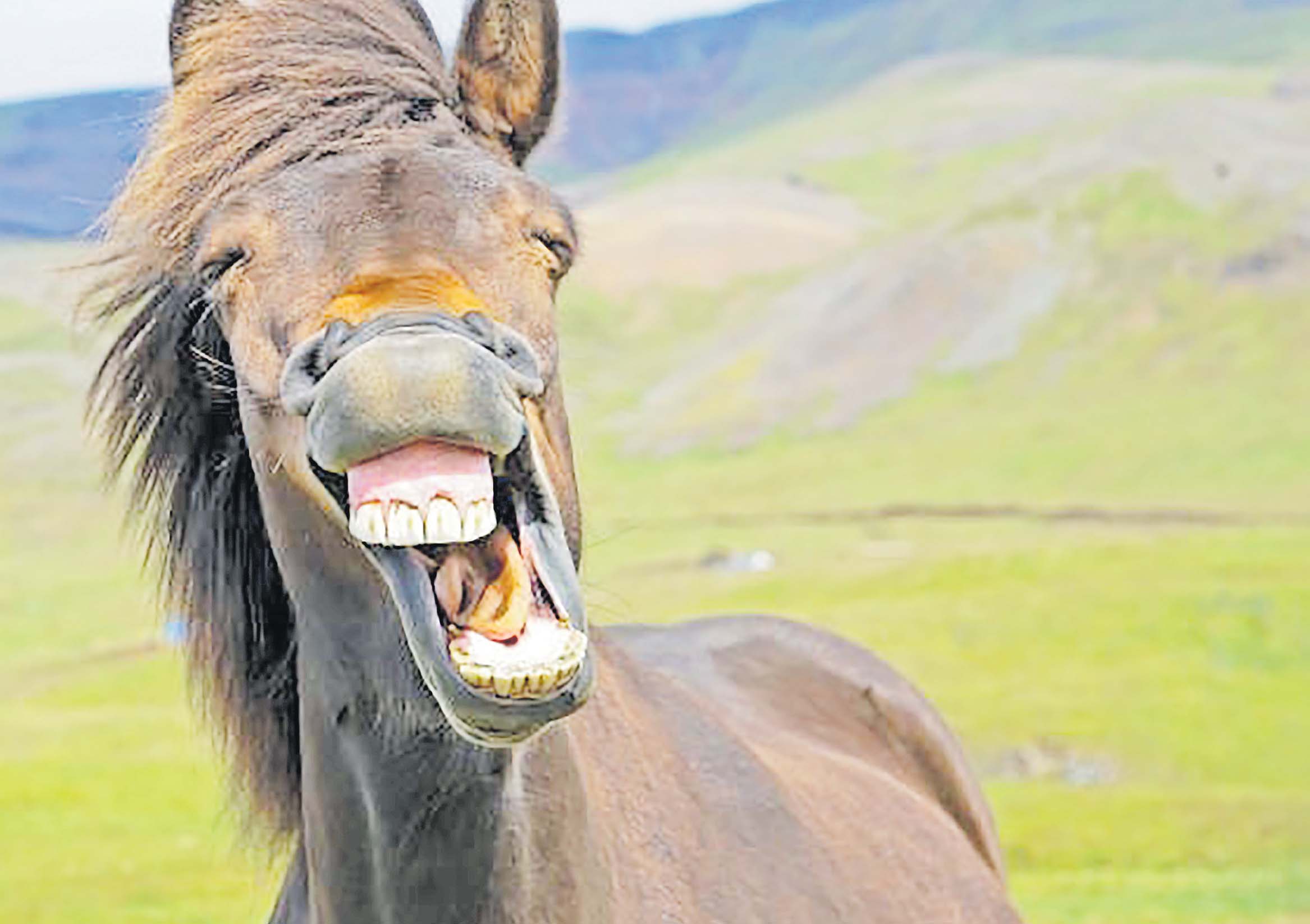It’s been raining cats and dogs lately so let’s get some things straight from the horse’s mouth.
Horses have many predators in the wild, so to survive, they learned to quickly react to something near they believe may hurt them and to stay away from strange things.
This is useful and life-saving in the wild, but it means riders have to beware, adapt and help their horse learn to relax.
This can be a challenge because the “fight or flight” response is an ingrained reflex which developed as animals learned how to protect themselves.
While they can see things with a panorama view there are some considerable differences between horse and human vision.
The horse sees a broad band of the world to the sides and back of his body, but it is narrow.
The horse’s vision is poor above and below the level of his eyes.
In order to see something clearly they need to be closer to it, and often need to cock their head one way or the other – not useful if that thing is trying to eat you.
They are keenly aware of movement, but because the clarity is lacking the response is flight.
Equine eyes are eight times larger than human eyes; in fact, they are larger than those of any other land mammal.
But a horse’s acuity – the ability to discriminate fine detail while focusing on something in the centre of the visual field – is considerably worse than ours.
Reading is a great example of acuity.
Right now, your eyes are picking up tiny differences on this page.
You can see the difference between an “e” and a “c,” for example.
For you, it’s clear, sharp and bright – for your horse it will look fuzzy and faded without careful and close scrutiny.
The horse only breathes through its nostrils.
They cannot normally breathe through their mouth like we can.
The nasal passages in the horse are separated from the oral (mouth) cavity.
Horses only breathe through their mouths if they have an injury or abnormality to the soft palate (the structure that separates the mouth from the nasal passages).
That horse which has just detected danger will give a snort and run away quickly and because they can only breathe through their nostrils you might hear snorting with each stride.
And if you watch carefully during walk and trot breathing and gait are not linked, but in canter and gallop horses take one breath perfectly in time with each stride.
No foot, no horse
What allows that horse to bolt quickly from danger, real or perceived is an engineer’s delight of tendons which store energy when they are stretched and give more than 90 per cent of that energy back as the horse foot leaves the ground.
Some describe it as the horse catapult.
Disease of the horse foot such as laminitis essentially keeps the horse on the ground, unable to move normally. (Laminitis is an inflammation of the horse foot between the hard hoof wall and underlying bone which can lead to life-threatening separation of those two structures).
All horses require regular hoof care, but not all horses need horseshoes.
For many horses, only regular trims are necessary for maintaining healthy hoof length and shape.
A good habit is to check and clean (with a hoof pick) your horse feet daily – a good thing for foals to learn when they are young is to allow each foot to be picked up and held, along with other handling.
This early training makes for a well-adjusted horse not easily frightened – safer for the horse and the people around it.
Eat like a horse
A typical 1000 lb (454kg) horse will graze approximately 12-18 hours/day – this is healthiest for their digestive system.
Horses are spot grazers, they have specialised mouths to select and eat the tops of the plants that they like.
They rarely graze in “rough areas” or areas where they defecate if given a choice.
Perhaps it is this constant eating from which the term arose.
A horse’s stomach is approximately four gallons and is the smallest in relation to its size.
The horse’s large intestine accounts for 60 per cent of the total volume of the digestive tract.
The section of large intestine called the cecum contains active bacteria similar to the microbes of the rumen.
The systems are opposite each other.
Because tethering is a common restraint used by many in Fiji, it would be useful to point out some problems with tethering horses.
Tethering negatively impacts a horse’s wellbeing in many ways.
A tethered horse needs high levels of monitoring, proper tethering equipment, feed, water and a degree of freedom regularly.
It’s not a lowcost or low-maintenance way of keeping a horse, and it’s not considered to be good practice.
Here are some of the problems it can cause.
• Lack of shelter
If a horse is tethered to a tree, it can become entangled and harm itself. If it’s tethered on open ground, it has no protection from flies or extreme weather
• Limited grazing
Although a limited amount of grazing may be accessible to a horse which is tethered, this grazing will soon be cropped to the floor or fouled with droppings. A tethered horse must be moved to fresh grazing regularly in
order to maintain a healthy diet. Remember our notes above.
However, even this can’t mimic a horse’s natural behaviour of walking long distances while grazing.
A horse should also have access to clean drinking water all the time.
A horse left unattended may kick over a bucket of water, and then be left without water for a long time.
• No company
Tethered horses can’t safely enjoy the natural company and interaction with other horses that they need, especially physical interactions such as mutual grooming.
• Physical safety issues
There are obvious health and welfare issues around tethering horses, including the dangers of entanglement and injury involved with attaching a chain or rope to a horse and leaving it constrained.
Long-term grazing on the same ground repeatedly can also lead to a higher than normal presence of worms, or worm burden, which can be dangerous.
• Stopping a horse’s natural behaviour
When horses are alarmed, their instinct is to run away. When a tethered horse is frightened, they can’t do this. This is a very basic denial of the freedom to behave normally, and may make the horse more frightened. A tethered horse will also be unable to roll freely and safely in a chosen spot.
A horse! A horse! My kingdom for a horse! – Shakespeare
• See more on horse vision in this interesting article – https://equusmagazine. com/behavior/eye-eye-31022.
- JO OLVER is a Doctor of Veterinary Medicine (DVM) with SPCA Fiji Islands. The views expressed are those of the author and do not reflect the views of this newspaper.





